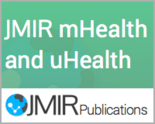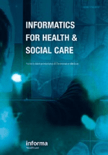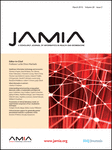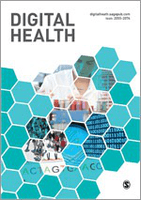
JMIR mHealth and uHealth
Scope & Guideline
Empowering Health Outcomes with Technology
Introduction
Aims and Scopes
- Mobile Health Interventions:
Research on the design, implementation, and efficacy of mobile health interventions aimed at improving various health outcomes, including chronic disease management, mental health support, and preventive care. - Wearable Technology:
Studies exploring the use and effectiveness of wearable devices in health monitoring, physical activity tracking, and chronic disease management, emphasizing data accuracy and user engagement. - Digital Behavioral Health:
Investigations into digital mental health interventions, including apps and platforms aimed at managing conditions like depression, anxiety, and substance use disorders. - Health Data Analytics:
Research focusing on the collection, analysis, and interpretation of health data generated from mobile health applications and wearables, including the use of machine learning and artificial intelligence. - Telehealth and Remote Monitoring:
Exploration of telehealth solutions and remote monitoring systems that facilitate patient care, particularly in chronic disease management and during public health emergencies. - Patient Engagement and User Experience:
Studies that assess user engagement, satisfaction, and the overall experience of individuals using mobile health applications, highlighting factors that influence adherence and usability. - Public Health and Policy:
Research addressing the implications of mobile health technologies on public health policy, including access to care, health equity, and regulatory considerations.
Trending and Emerging
- Artificial Intelligence and Machine Learning:
There is a growing trend towards leveraging AI and machine learning techniques in mobile health applications for predictive analytics, personalized interventions, and improving the accuracy of health monitoring. - Gamification in Health Apps:
Research on gamification strategies used in mobile health applications is on the rise, highlighting its effectiveness in enhancing user engagement and motivation for behavior change. - Integration of Social Media:
Emerging studies focus on the integration of social media platforms within mobile health interventions, exploring their potential to enhance community support and information dissemination. - Chronic Disease Management:
An increasing number of papers are dedicated to mobile health solutions for chronic disease management, particularly in conditions like diabetes, hypertension, and mental health disorders, emphasizing the importance of ongoing patient support. - User-Centered Design:
There is a clear trend towards utilizing user-centered design principles in the development of mobile health applications, ensuring that user needs and preferences are prioritized in the design process. - Data Privacy and Security:
With the rise of digital health tools, there is an emerging focus on the privacy and security of health data collected through mobile applications, reflecting growing concerns among users and regulators.
Declining or Waning
- Traditional Health Education Methods:
There has been a noticeable decrease in studies focusing solely on traditional health education methods without the integration of mobile technologies, as the field moves towards more interactive and engaging digital solutions. - Generic Health Apps:
Research on generic health applications that lack specific targeting or tailored interventions has diminished, as there is a growing emphasis on personalized and context-sensitive mobile health solutions. - Solely Text-Based Interventions:
The effectiveness of text-based interventions without multimedia or interactive components has seen a decline, as more comprehensive approaches utilizing video, gamification, and interactive elements gain traction. - Single Disease Focus:
Research that concentrates exclusively on interventions for single diseases without considering comorbidities or holistic approaches has decreased, reflecting a trend toward integrated health management strategies.
Similar Journals

JOURNAL OF MEDICAL INTERNET RESEARCH
Connecting Healthcare and Technology for a Healthier TomorrowJOURNAL OF MEDICAL INTERNET RESEARCH, published by JMIR PUBLICATIONS, INC, stands as a pivotal resource in the field of Health Informatics, with an esteemed ranking of #7 out of 138 in the Scopus database, placing it in the top 95th percentile. Since its inception in 1999, this Open Access journal has been committed to disseminating high-quality, peer-reviewed research that explores the intersection of healthcare and internet technologies. With its headquarters in Toronto, Canada, the journal encompasses a broad range of topics, including eHealth, telemedicine, and mobile health innovations. The impact factor and its Q1 quartile ranking highlight the journal's significant influence and prevalence in advancing the understanding of digital health landscapes. Researchers, professionals, and students alike benefit from its valuable insights, making the JOURNAL OF MEDICAL INTERNET RESEARCH an essential tool for fostering informed practices and policy-making in the rapidly evolving domain of health informatics.

Healthcare Technology Letters
Bridging the gap between technology and health outcomes.Healthcare Technology Letters is a leading open-access journal published by WILEY that has been at the forefront of disseminating cutting-edge research in the field of health informatics and health information management since its inception in 2014. With an E-ISSN of 2053-3713, this esteemed journal is recognized for its commitment to advancing knowledge and practice in healthcare technology, making it a vital resource for researchers, professionals, and students alike. The journal's scope encompasses a wide range of topics, including digital health solutions, data management, and innovative technologies that enhance patient care. It holds a respectable position in the academic community, featuring a Q3 ranking in both health informatics and health information management as of 2023, and consistently contributing to high-impact research evidenced by its Scopus rankings. By providing open access to its content since 2017, Healthcare Technology Letters ensures that valuable insights and breakthroughs can reach a broader audience, furthering the impact of its published work on the global health landscape.

CIN-COMPUTERS INFORMATICS NURSING
Exploring New Frontiers in Nursing InformaticsCIN-COMPUTERS INFORMATICS NURSING is a distinguished journal that publishes cutting-edge research at the intersection of nursing and information technology. Published by Lippincott Williams & Wilkins, the journal has been a pivotal platform since 2002, catering to the needs of health informatics professionals and nursing researchers. With an impressive impact factor and ranked within Q2 in Nursing (miscellaneous) and other relevant categories, it serves as a key resource for advancing knowledge and best practices in the field. The journal's inclusion in important databases ensures broad visibility and access to the latest findings that influence healthcare delivery. CIN-COMPUTERS INFORMATICS NURSING welcomes a diverse range of articles, including empirical studies, reviews, and innovative methodology approaches, making it an invaluable asset for clinicians, educators, and scholars dedicated to enhancing nursing informatics and improving patient outcomes.

Informatics for Health & Social Care
Exploring the future of care through informatics.Informatics for Health & Social Care is a leading journal published by Taylor & Francis Inc, dedicated to the intersection of health informatics and social care. With a strong emphasis on advancing knowledge in the fields of health information management and nursing, this journal has established itself as a vital resource for researchers and professionals seeking to explore innovative applications of informatics to improve patient outcomes and streamline healthcare delivery. Recognized for its influential contributions, it currently holds a Q2 ranking in both Health Informatics and Health Information Management, as well as a prestigious Q1 ranking in Nursing (miscellaneous) for 2023, signifying its critical role within the academic community. The journal is accessible for open access viewing, fostering a broader dissemination of research findings. Released continuously since 1976, it stands as a testament to the evolving landscape of health informatics, addressing pertinent issues and facilitating discussions that shape practices in health and social care delivery.

JOURNAL OF TELEMEDICINE AND TELECARE
Empowering health informatics for a connected world.JOURNAL OF TELEMEDICINE AND TELECARE, published by SAGE PUBLICATIONS LTD, stands at the forefront of the rapidly evolving fields of health informatics and telemedicine. With its ISSN 1357-633X and E-ISSN 1758-1109, this prestigious journal has been a vital platform for innovation and research since its inception in 1995, covering a wide array of topics from remote patient monitoring to the integration of artificial intelligence in healthcare delivery. Recognized for its rigorous academic standards, the journal boasts an impressive impact factor, positioning it in the Q1 quartile for Health Informatics and securing a remarkable rank of #9 out of 138 in Scopus, placing it in the 93rd percentile among its peers. By disseminating high-quality research, the JOURNAL OF TELEMEDICINE AND TELECARE contributes significantly to the advancement of knowledge, shaping best practices in telehealth and enhancing patient care worldwide. As a non-open access journal, it appeals to a broad audience of researchers, healthcare professionals, and students, facilitating critical discourse on the future of healthcare technology. Stay at the forefront of this essential domain by engaging with the latest findings and projects featured in this influential publication.

International Journal of E-Health and Medical Communications
Advancing e-health research for a connected world.Welcome to the International Journal of E-Health and Medical Communications, a pivotal publication designed to bridge the gap between health informatics and computer science applications. Published by IGI Global, this journal serves as a platform for innovative research and insights into e-health technologies, health communication strategies, and the evolving role of digital tools in enhancing healthcare delivery and management. With an ISSN of 1947-315X and E-ISSN 1947-3168, it caters to an audience keen on advancing the intersection of technology and health, as evidenced by its respectable standings in Scopus rankings—positioned in the 64th percentile in Health Informatics and 63rd in Computer Science Applications. Over its publication history from 2010 to 2024, the journal has consistently contributed to significant discussions and advancements within these fields, highlighted by its Q3 quartile ranking in 2023. Join a community of researchers, professionals, and students dedicated to the ongoing exploration of e-health, as we collectively navigate the complex landscape of healthcare innovation.

JOURNAL OF THE AMERICAN MEDICAL INFORMATICS ASSOCIATION
Fostering Interdisciplinary Collaboration in Health InformaticsThe Journal of the American Medical Informatics Association, published by Oxford University Press, stands as a premier publication within the field of Health Informatics, showcasing cutting-edge research and innovative practices. With an impressive Q1 category ranking in 2023 and a remarkable Scopus rank of #6 out of 138, this journal consistently contributes to the advancement of knowledge and application in medical informatics, making it a vital resource for researchers, healthcare professionals, and students alike. Since its inception in 1994, the journal has fostered interdisciplinary collaboration and provides a platform for high-quality research that drives improvements in healthcare practices and technology. Although it operates on a subscription model, the journal's impactful findings and comprehensive analyses are essential for those looking to stay at the forefront of health informatics innovations.

Frontiers in Digital Health
Catalyzing Innovation in Digital HealthFrontiers in Digital Health is an innovative peer-reviewed journal published by FRONTIERS MEDIA SA, focusing on the intersection of digital technology and healthcare. As an Open Access journal since 2020, it aims to democratize knowledge by making cutting-edge research freely available to the global community. The journal covers a wide array of topics within the realms of Biomedical Engineering, Health Informatics, and a variety of Computer Science Applications, ensuring interdisciplinary collaboration and advancements. Recognized for its excellence, it holds prestigious rankings in multiple categories, including Q1 in Biomedical Engineering and Q2 in several related fields according to the 2023 metrics. Set in the heart of Switzerland, the journal fosters a comprehensive approach to enhancing digital health technologies, making it an essential resource for researchers, professionals, and students dedicated to improving health outcomes through innovation.

Lancet Digital Health
Advancing the Future of Healthcare Through Digital Innovation.Lancet Digital Health is an esteemed Open Access journal published by ELSEVIER, dedicated to advancing the interdisciplinary field of digital health. Since its inception in 2019, the journal has rapidly established itself as a leading platform for disseminating high-quality research focusing on the implications of digital technology in healthcare delivery, health informatics, and patient management. Renowned for its rigorous peer-review process and commitment to academic excellence, Lancet Digital Health currently holds prestigious Q1 rankings across multiple categories including Decision Sciences, Health Informatics, and Medicine (miscellaneous) as of 2023. With an impressive impact in its field—ranked #1 in Health Informatics and within the top percentile of related disciplines—this journal offers vital insights into the ongoing transformations within health systems globally. Researchers, healthcare professionals, and students alike will find a wealth of cutting-edge studies, practical applications, and discussions on the future of digital health, fostering an evidence-based dialogue that is essential in today's rapidly evolving medical landscape.

Digital Health
Shaping Health Outcomes Through Open Access Research.Digital Health is a pioneering open-access journal published by SAGE Publications Ltd, dedicated to advancing the field of health technology and its intersection with health policy, informatics, and the broader medical landscape. Since its inception in 2015, the journal has rapidly established itself as an essential resource for researchers, professionals, and students, serving as a platform for innovative research that leverages digital tools to improve health outcomes. Currently ranked in the Q2 category across four relevant domains, including Computer Science Applications and Health Informatics, it commands respect within the academic community. With its accessible framework, Digital Health facilitates the dissemination of critical findings and new methodologies that inform policy and practice. The journal’s commitment to open access promotes worldwide access and cooperation, making significant contributions to the evolving landscape of digital health.